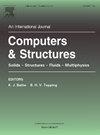基于Bloch-Floquet理论的最佳体积分数目标带隙晶格结构拓扑优化
IF 4.4
2区 工程技术
Q1 COMPUTER SCIENCE, INTERDISCIPLINARY APPLICATIONS
引用次数: 0
摘要
在这项工作中,我们开发了一种拓扑优化算法,通过应用布洛赫-弗洛特定理,仅使用一个单元格就能设计出在目标频率附近显示带隙的双材料晶格结构。在双材料插值的基础上,采用了双向进化结构优化(BESO)方法。该方法定义了一个新的目标函数,只使用最接近目标频率的自然频率,而不考虑它们相对于基本自然频率的位置。这通过限制考虑的频率数量降低了计算成本,并提高了优化过程的稳健性,因为这些频率能够适应域内材料分布的变化,不断涵盖目标频率。此外,还采用了一种新颖的方法来确定构成结构的材料的最佳体积分数,而在其他研究中,这一参数通常是在开始优化过程之前预先确定的。因此,该算法可以自主确定在目标频率附近产生最宽带隙的体积。该算法针对一维(1D-CR)和二维(2D-CR)单元格周期性重复形成的晶格结构的不同情况进行了评估,并将一些结果与其他著作中通过不同方法获得的结果进行了比较。本文章由计算机程序翻译,如有差异,请以英文原文为准。
Topology optimization of lattice structures for target band gaps with optimum volume fraction via Bloch-Floquet theory
In this work, a topology optimization algorithm has been developed to design bi-material lattice structures showing a band gap around a target frequency, using just one unit cell through the application of Bloch-Floquet theorem. The Bidirectional Evolutionary Structural optimization (BESO) method has been employed, based on bi-material interpolation. A new objective function has been defined, which uses only the natural frequencies closest to the target one, regardless of their position with respect to the fundamental natural frequency. This reduces the computational cost by limiting the number of frequencies considered, and improves the robustness of the optimization process, as these frequencies adapt to changes in the distribution of materials within the domain, constantly encompassing the target frequency. In addition, a novel approach has been implemented to determine the optimal volume fraction of the materials forming the structure, a parameter typically predefined in other works before starting the optimization process. Consequently, the algorithm can autonomously identify the volume that produces the widest band gap around the target frequency. The algorithm has been evaluated for different cases of lattice structures formed by the periodic repetition of a unit cell in both 1D (1D-CR) and 2D (2D-CR), comparing some results with those obtained in other works through different approaches.
求助全文
通过发布文献求助,成功后即可免费获取论文全文。
去求助
来源期刊

Computers & Structures
工程技术-工程:土木
CiteScore
8.80
自引率
6.40%
发文量
122
审稿时长
33 days
期刊介绍:
Computers & Structures publishes advances in the development and use of computational methods for the solution of problems in engineering and the sciences. The range of appropriate contributions is wide, and includes papers on establishing appropriate mathematical models and their numerical solution in all areas of mechanics. The journal also includes articles that present a substantial review of a field in the topics of the journal.
 求助内容:
求助内容: 应助结果提醒方式:
应助结果提醒方式:


